How Does A Capo Change The Key
Using a capo is a valuable skill for anyone learning guitar. Fortunately it'southward not hard to larn how to use a capo properly, though there are a few things you need to know to get the maximum benefit from this simple but powerful tool.
There are several different ways to employ a capo on the acoustic guitar. However 90% of the time it's used to alter the pitch of a vocal upwards or downward to make it easier for either you or someone else to sing forth with.
It's not the only fashion to change the pitch of a song to accommodate the vocaliser, just it is oftentimes the quickest and easiest manner.
Past learning how to use a capo in this way you'll besides be developing the ability to use it for other purposes as well…
Kinda a "threefer"... that's like a twofer but more than… well, you get the idea.
What Is A Capo... And Why Use One?
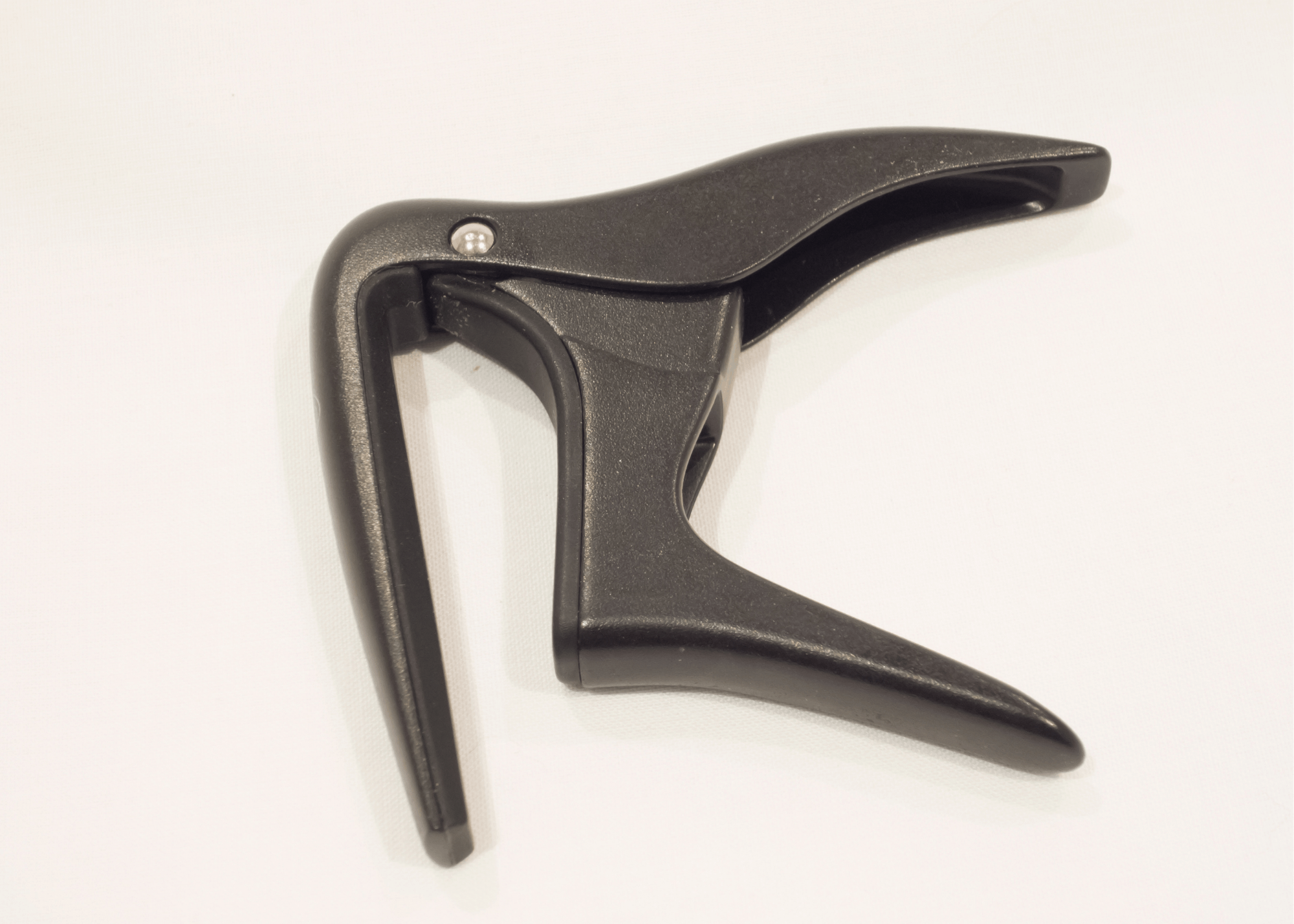
I'll get-go off with what capo is for in the basics of using it.
And so I'll cover more in-depth aspects of raising and lowering the pitch of a song using a capo. This will include a cursory music theory lesson on changing keys. If you don't know what that means yet don't worry. Y'all're in the correct identify.
Finally I'll give you a Jam track that you can employ to get more adept with the techniques yous'll learn.
Let'southward become started with some capo basics…
Capo Basics: The Movable Guitar Nut
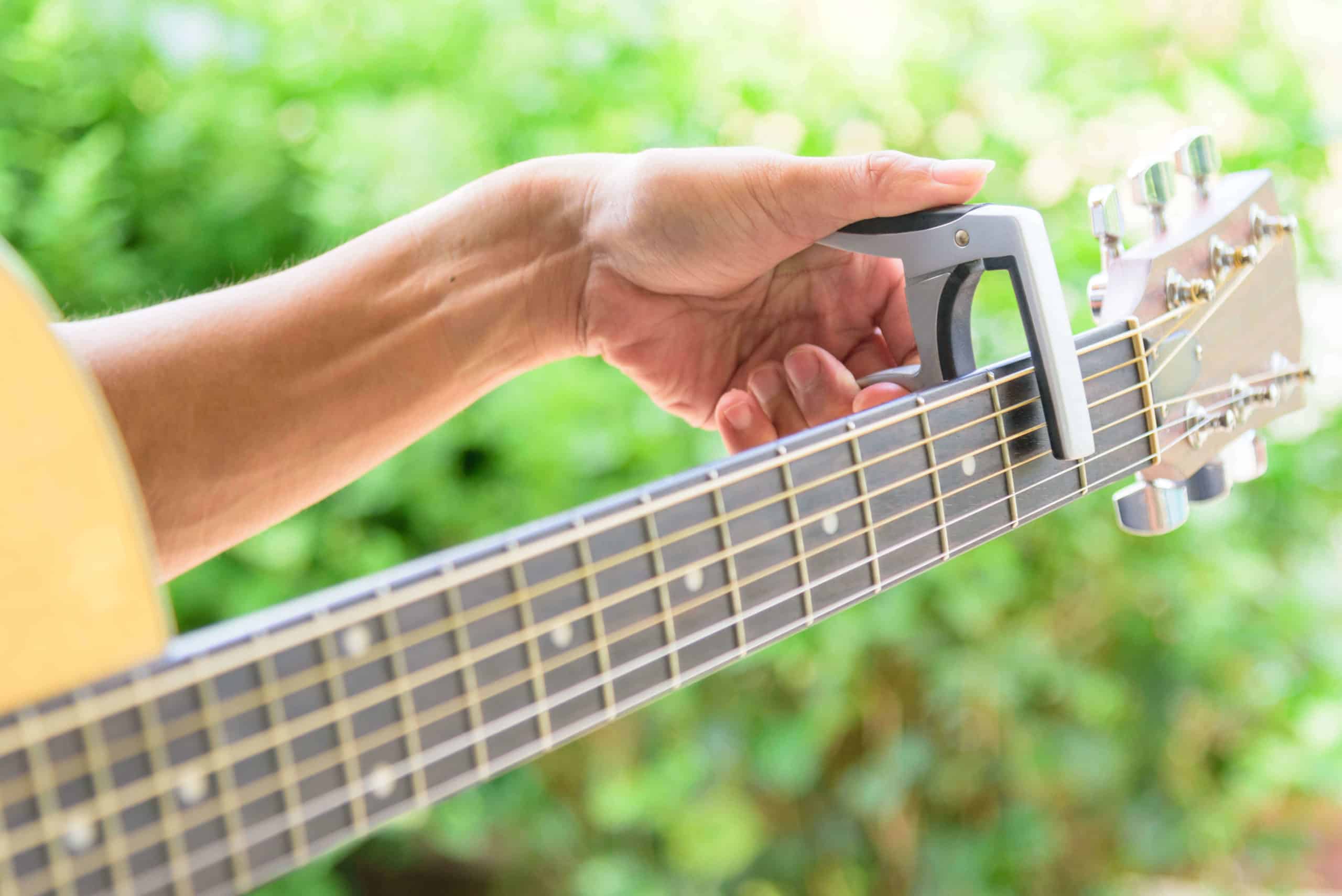
When you play an open up chord on the guitar some of the notes are being created past where you put your fingers on the frets. Others are what we call "open up". Where the cord meets the nut of the guitar is what creates the note… this little white thing the the strings sit on.
If you motility the chord up the guitar cervix it won't audio right anymore because the open up strings didn't change. They're still making the aforementioned note as before where they sit down on the nut.
1 fashion to recall of a capo is equally a kind of movable nut for the guitar. You can put the capo on, for example, the second fret. Then play that aforementioned chord upward ii frets. Now all the open strings will move up to frets too in the chord will sound right.
In this instance I'm making a Thou grade of the chord. It's important that nosotros distinguish betwixt the guitar chord grade and the chord audio. In this example they're one and the same. When I play that G chord without a capo it's both the G chord form and it sounds similar a G chord.
Now when I put the capo on the 2nd fret and finger the G chord form it's no longer the sound of a Grand chord. By moving information technology up two frets it becomes an A chord.
Up two frets means going from G, to G#, and then to A...
Here'due south some other example. Now I'm playing a C chord form that is too a C chord audio. When I put the capo on the second fret I can still play the C chord form, but it's no longer the sound of the C chord. I raised it upward 1. To get the sound of a D chord.
Pitch
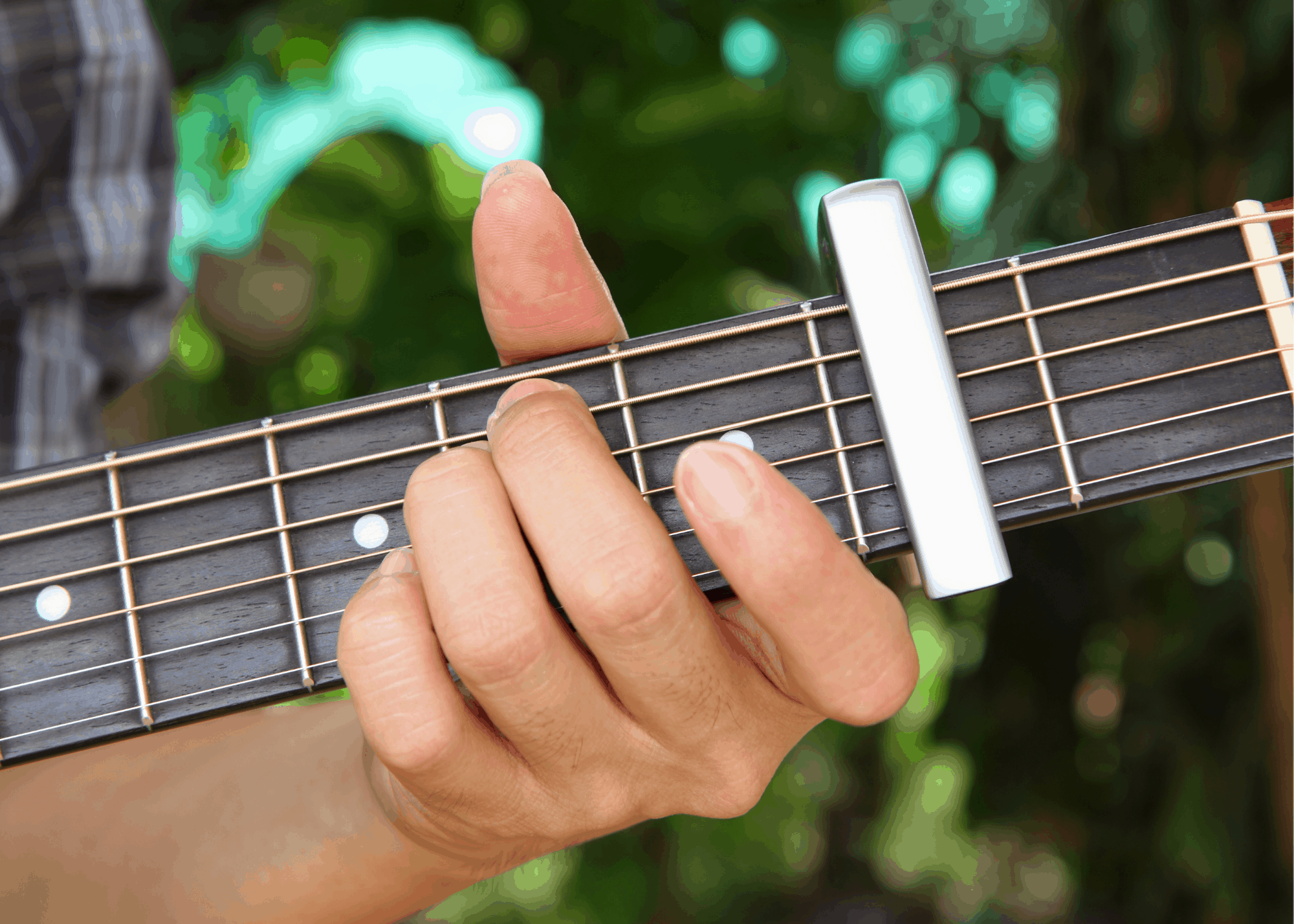
Let's talk virtually pitch. When we say we're raising the pitch of a song what we're doing is making the audio college. When you lot lower the pitch you lot make the audio lower. For instance if I play this notation on the guitar (play note) and I desire to raise the pitch I'll motion my finger upwards the guitar neck. Now the pitch is going higher.
The same applies when I move my finger in the other direction the pitch goes down. The sound is lower.
Sometimes you'll want to enhance or lower the pitch of a vocal to brand it easier to sing. It's common to say, in this state of affairs, that y'all are changing the "central" of the song.
There's a relationship between the pitch and the fundamental of a song, merely non exactly the same affair.
The principal thing y'all want to know right at present is that by changing the key of a song you will raising or lowering the pitch.
Raising the Key or Pitch of a Vocal
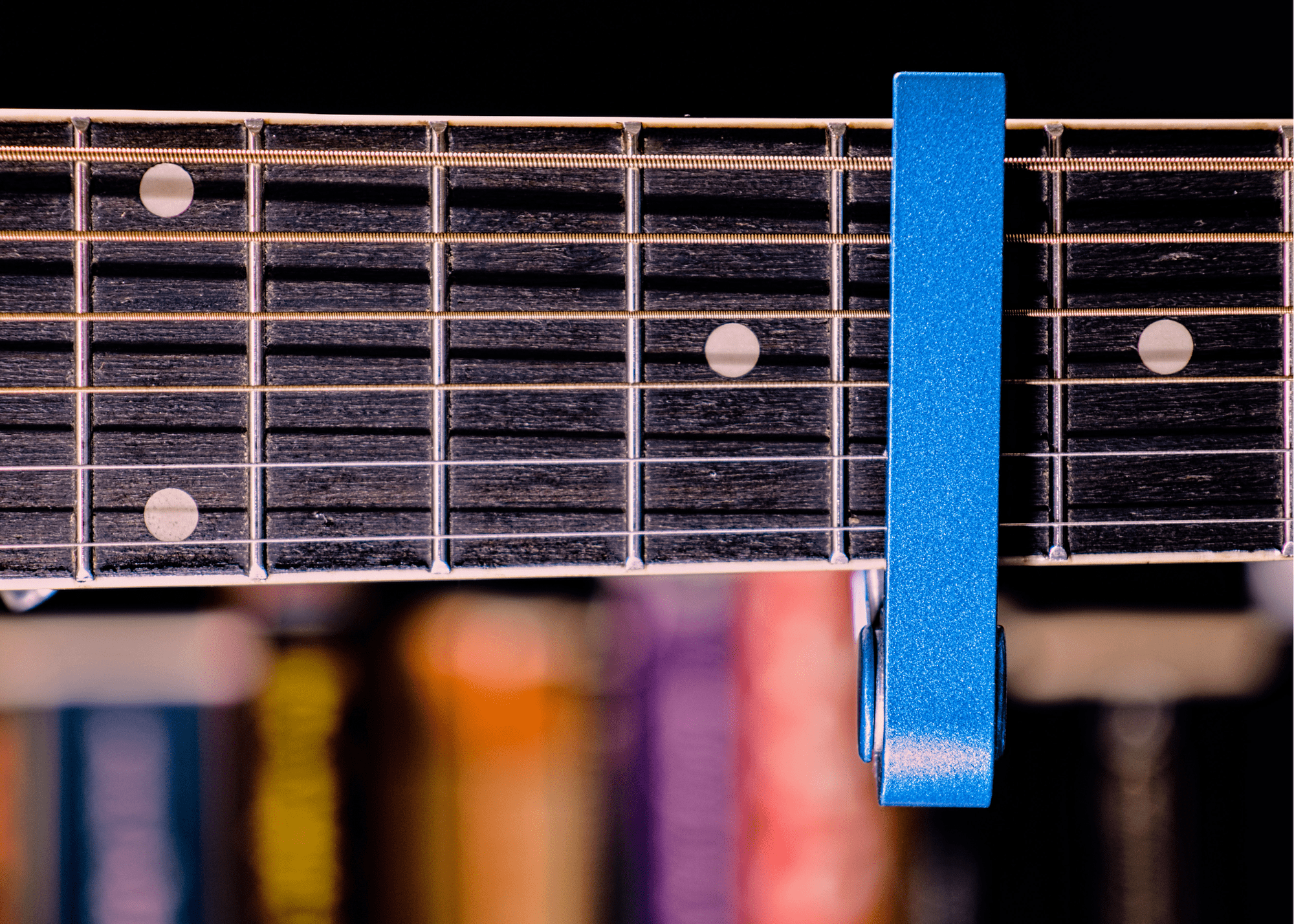
This start by using an example of a song that starts with the G chord. For this case volition use the G chord, the C chord and the D chord. We could say this song is in the key of Thousand. These three chords can establish the sound of the key of G.
If I wanted to raise the pitch of the song I could use a capo. I can put the cablevision on the first fret and I would raise the unabridged pitch of the song by one fret, or one half step. As yous may know 1 fret on the guitar is equal to one half footstep.
If I put the capo on the second fret I would be raising the pitch of the song by one whole step. Ii half steps equal one whole step.
The song is now in the key of A.
If I move the capo up another one-half step it will now be in the key of A sharp. Another half stride and it will be in the key of B.
This is an easy mode to raise the pitch of a song if the song is low for the singer'south vocalization. Simply what if the vocal is already too high and you need to brand the pitch lower?
Lowering the Key or Pitch of a Song
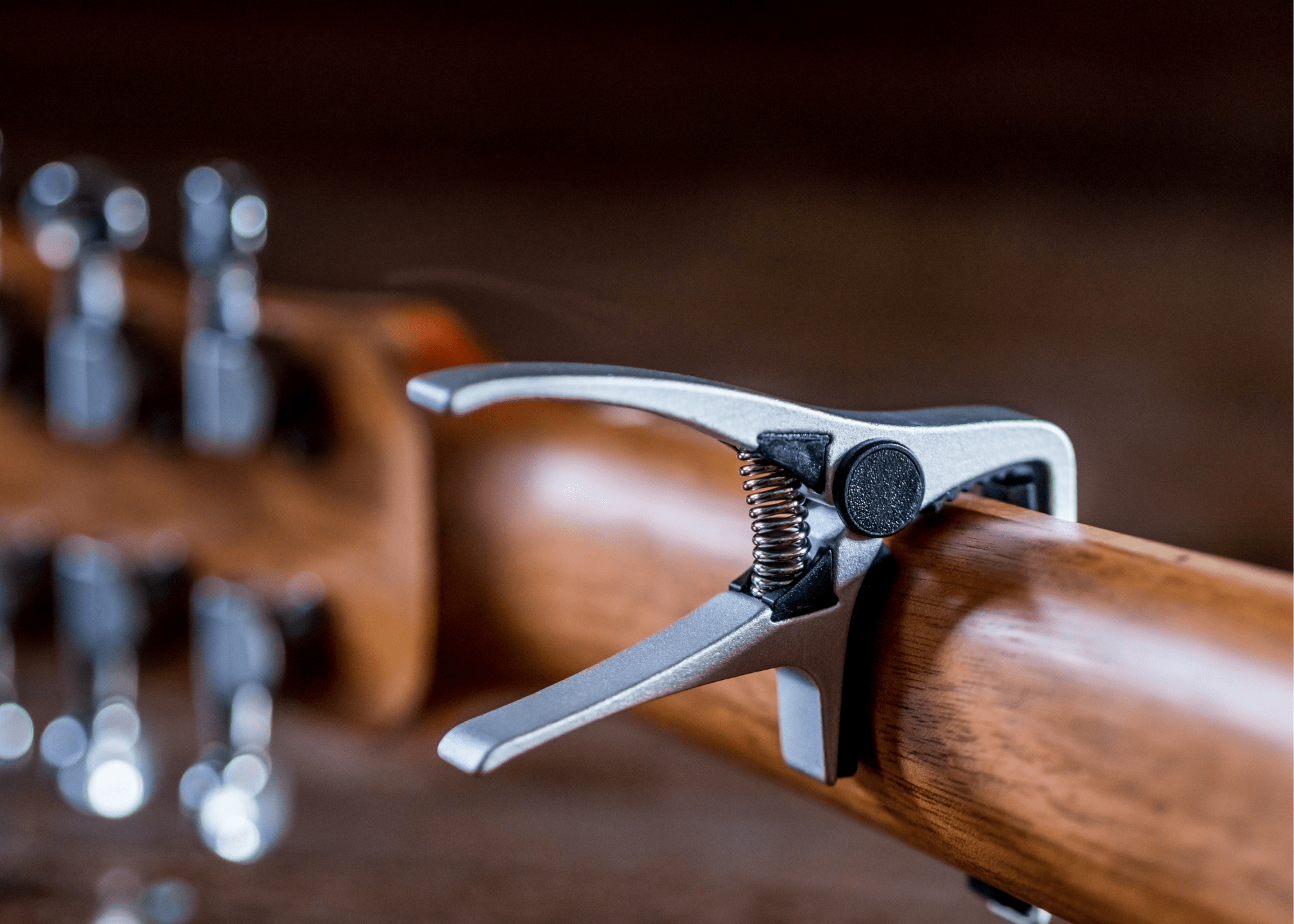
What nosotros're going to do is bound downward in pitch past changing the chords of the song then that the song is in a much lower primal. Then we'll use the capo to refine the modify by putting information technology on one fret at a fourth dimension until we've raised information technology to the right key.
This is where a brief lesson in changing the key of a song will come in handy.
A simple definition of the key of a song would be the notation or chord that sounds like the tonic or home. In other words, a place of residue on that note or chord. Using notes and chords from the scale for that key established the cardinal.
Let's use the fundamental of Grand as an example. A song in the fundamental of Thou would have a tune composed of notes from the G calibration. Chords would come from notes from the G calibration. Information technology'due south also common, but not absolute, to brainstorm and end the song on the tonic chord... In this case the G chord.
To jump downward to a lower key I would pick a key that's quite a bit lower and still easy to play on guitar. Then I would change all the chords to match the new cardinal. One way to do this would exist to count the distance from the old chords to make it at the new chords.
Here's an case. Let's use a song that in the cardinal of Grand and uses the G chord, the C chord in the D chord. I want to bound down to the key of D.
Here's a quick review of the musical alphabet.
A - B - C - D - E - F - Yard
And then starts over once again.
We're going to go down 3 notes. Nosotros will be going down from G, to F, E, and arrive at D.
Now for the G chord you lot would apply the D chord instead.
For the original C chord you would countdown 3 notes…
C, to B, A and then to K.
At present will do the aforementioned matter for the final chord in our song… The D chord.
Counting downwards nosotros become from D, to C, B and get in at A.
The new chords for our song are the D chord, the G chord, and the A chord.
We can now say we take transposed, or inverse, exercise the key of D.
That's cool. Now we know how to transpose a song.
Now I would test it out and see if in fact this is too low. If information technology is I would first putting my capo on one fret at a time until information technology seemed about correct.
For instance… If I put my capo on the first fret I would now exist raising the pitch past one one-half step. I tin too say I've raised the key from D to D sharp.
If I put the capo on the second fret I've raised it up to have steps, or to the key of E.
Only what if, subsequently transposing the song to the key of D, it notwithstanding seems to high?
One of the things I could exercise is to transpose the song to an fifty-fifty lower central. In this case I could transpose the song to the key of A. For practice let's practise that transposing exercise one more time.
Here'due south the musical alphabet again
A - B - C - D - E - F - Thou
Starting from the G chord over again I could count back half-dozen notes to go to A.
Another way to do this would exist to count up i annotation. Since the musical alphabet goes in the wheel counting up 1 note is the same as counting back 6. For me information technology's easier to count up… And then let's exercise that in this instance.
For the original C chord let's go upward one note to D…
For the D chord we'll get up to E.
The new chords for our song are the A chord, the D chord, and the Eastward chord.
Nosotros tin can now say nosotros have transposed, or changed, do the cardinal of A.
Over again I could use my capo to heighten from the primal of A by one-half steps until the sound is at the pitch I want.
If I put the capo on the starting time fret I would raise the pitch by i half pace... or to the fundamental of A precipitous. If I went with two frets I would be at the key of B.
On the third fret I would be at the central of C. Remember there's only one one-half step betwixt the B and C.
Changing Keys With A Capo Exercises
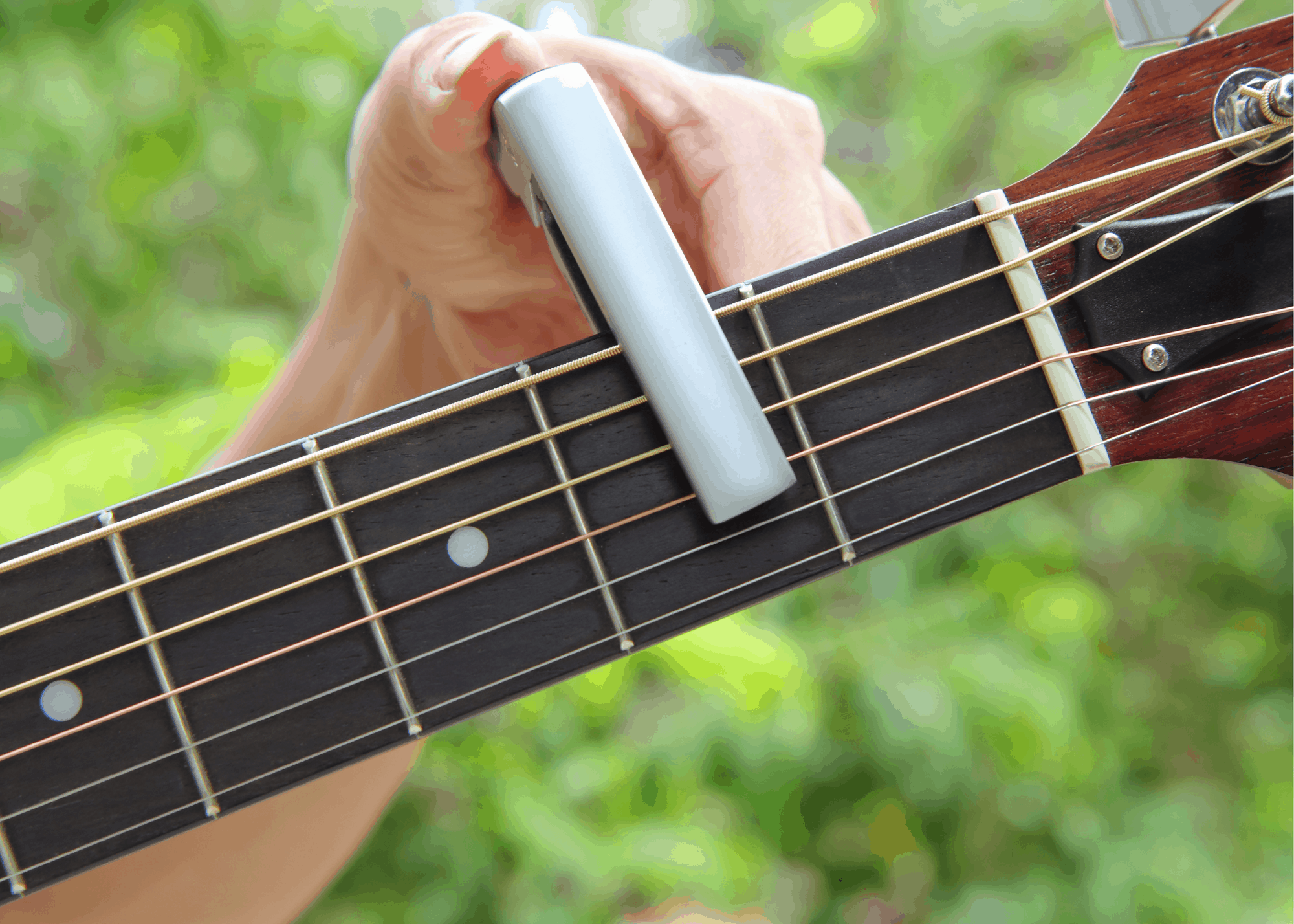
It's i matter to understand something intellectually merely another to really apply information technology. Here are 3 exercises that will help you integrate this understanding. Yous'll get the chance to play and hear the event of using a capo.
Exercise #1
Let's kickoff off by playing a simple chord progression. It's in the key of Grand. We'll play 1 measure out each of the Thou chord, the C chord in the D chord. Go ahead and play along with me.
At present y'all've heard what this progression sounds like in the key of One thousand. Let's put the capo on the second fret. We're going to play the same chord forms. Remember this will raise the key up one footstep to the fundamental of A. You will be playing the One thousand chord form but the sound will be one stride higher. Hither nosotros go.
Play these chord forms: |1000///|C///|D///|G///|
(Sounds in the key of A: A - D - East - A)
Exericse #2
Now for the second exercise we're going to play the aforementioned chord forms but put the capo on the fifth fret. This will raise the key to the primal of C. When you lot play that M chord course information technology will sound like a C chord.
The sound will be higher, or more tinny. But you'll even so be playing chords in the key of C. They are college sounding versions of the same chords.
Play these chord forms: |G///|C///|D///|1000///|
(Sounds in the fundamental of C: C - F - Thousand - C)
Exercise #3
For the third do I'll take you lot play the same vocal merely using unlike chords. Nosotros are going to transpose the vocal to the cardinal of A.
In identify of the Thousand chord use the A chord, for the C chord we'll utilise a D chord, and for the D chord will be using an E chord.
Go ahead and play along with me and so you tin can hear what this sounds like.
Now let's put the capo on the third fret.
Nosotros now raise the audio of the song to the fundamental of C. When y'all play the A chord class it will sound like a C chord. Go ahead and play along with me using the A chord, the D chord and the Due east chord forms.
Play these chord forms: |A///|D///|E///|A///|
(Sounds in the key of C: C - F - G - C)
Download Your Gratuitous Jam Tracks
I've created iii jam tracks that you tin download frets only no accuse to to help yous with these three exercises. It'due south a great way to both train your ear and integrate these ideas... And it's more fun than playing by yourself.
Play or Download the Jam Tracks for the Exercises Below:
Exercise #i:
I accept a quick question… What is your level of experience with a capo? Are you make-new, or have you been using a capo for years? Leave me a comment below.
Related Video:
Why & How to Use A Capo
Tell Us What Y'all Remember - Please Comment Below!
We would dear to hear your comments and questions. What specific things are you struggling with while learning guitar?
Add together To Pinterest
Download Your Gratuitous Jam Tracks
How Does A Capo Change The Key,
Source: https://www.tomasmichaud.com/use-capo-change-keys/
Posted by: tobinmors1941.blogspot.com


0 Response to "How Does A Capo Change The Key"
Post a Comment